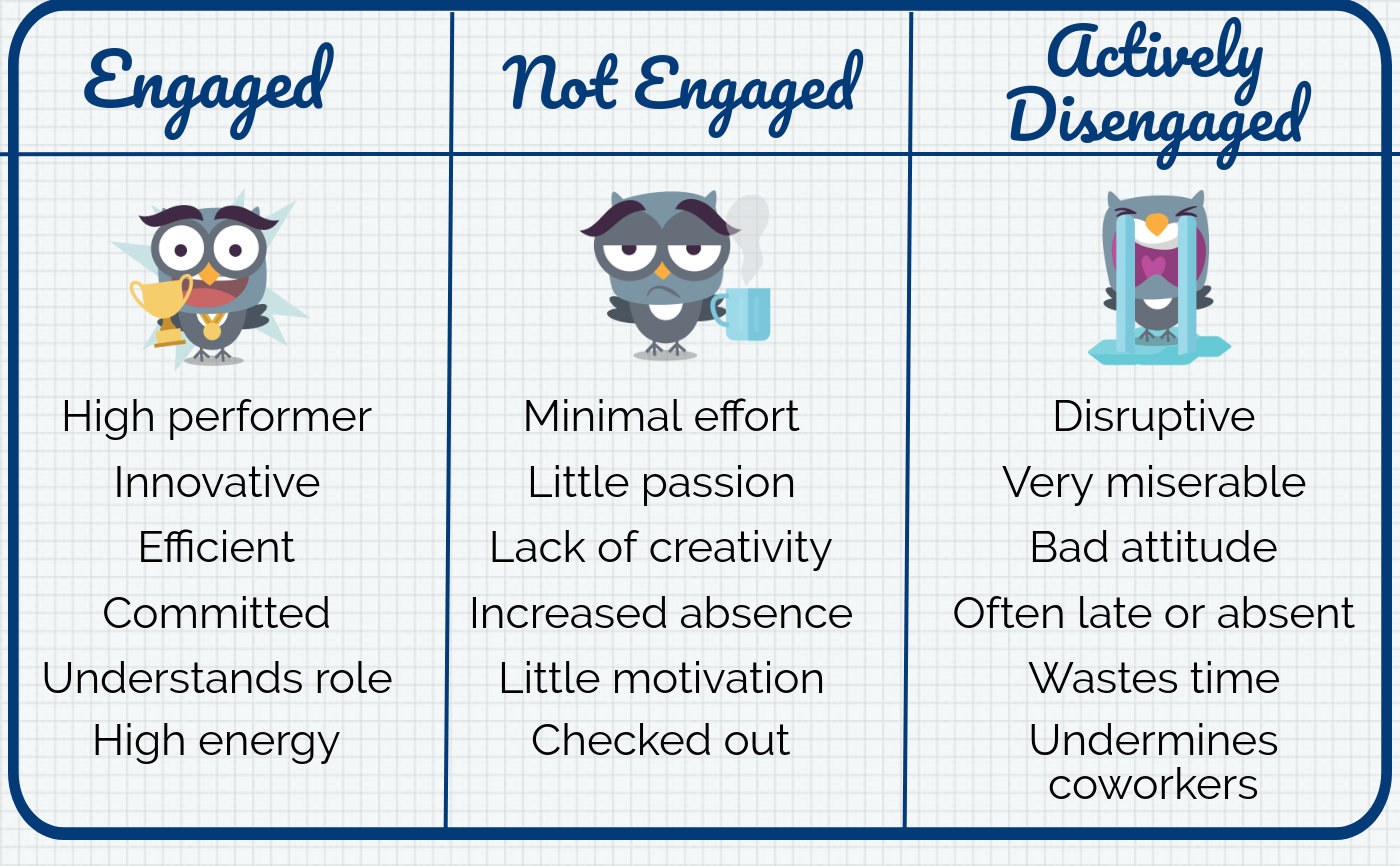Create a culture that means business™
Email address
People are always complaining about their jobs; whether it’s a boss who drives you up the wall, work that bores you to tears or even the nagging suspicion that you’re being underpaid, each unhappy employee has their own reasons for dreading a Monday morning. But when all this unhappiness and discontent gets added up, it turns out it’s having a profound impact on economies everywhere: we’re in the midst of a global employee engagement crisis, with just 13% of employees worldwide engaged with their jobs. So what exactly does this mean? An easy way to think about the benefits of employee engagement is to look at your existing staff. Engaged staff are often your best performing employees – they’re efficient, motivated, understand their role and tackle it to the best of their ability. Naturally, we think all employees will be like that when we hire them – otherwise, why bother?
During job interviews, most candidates are very enthusiastic about the job on offer and if you hire them, it’s normally this enthused and engaged person that you actually want working for you. Yet if you find yourself looking at that same excited candidate a year into the job and seeing that they’re unmotivated, checked out and unhappy, it’s clear that they’ve become disengaged. If that’s the case with many of your employees, you might have a problem brewing.

It doesn’t matter if your business is a tiny start-up or huge multinational corporation – disengaged staff can run it to the ground. As employee engagement drops off, business owners find that deadlines start getting missed, staff are constantly off sick and employees start leaving the business in droves. Work slows down to a crawl, leaving engaged staff to pick up the slack and heightening their stress levels (possibly leading to them hating their jobs too!)
Luckily, by focusing on the benefits of employee engagement and happiness, you can revive even the most lifeless of workforces. Read on to find out about the top benefits of employee engagement, along with some tips on how to improve it throughout your business.
1. Cost-savings
Disengaged staff are slowly draining the life out of your business. In the UK, employee disengagement is costing businesses around £340 billion every single year in lost productivity, while in the USA Gallup estimates this figure rises as high as $550 billion.
It’s easy to see how – if you’re paying someone to do a job and they’ve only put in half the effort necessary, they’ll still get paid even if you don’t get the results you need. As for very disengaged employees (often easily identified by their miserable and disruptive attitudes), you may as well be giving money away. Employee disengagement can easily decimate the return on investment on salaries.
On the other hand, engaged employees will improve your profitability and drive revenue. In fact, workforce opinion surveys show that highly engaged employees can boost business performance by 30%. This is because engaged employees are emotionally committed to their company, its values and its goals. They want the business to do well and will do their best to help it succeed. The hard numbers prove this too – companies with engaged employees outperform those without by 202%.
Luckily, there are ways you can help to foster this sort of commitment. For instance, people who are bored to death at their jobs are unlikely to care about it much, whereas 78% of employees who say their companies encourage creativity and innovation are committed to their employer. It’s easy for businesses to get into a “this is how we’ve always done it” rut and resist change, but data like this shows that this attitude is detrimental to employee engagement. Instead, actively encourage employees to innovate and explore new ways to do things. They’ll enjoy their jobs more, be more committed and help to power your business forwards.
2. Lower turnover
Reduced turnover is one of the top benefits of employee engagement that you can’t lose sight of. Did you know that whenever a staff member leaves, it can cost 33% of their salary to replace them? Hiring recruiters is expensive, but even if you look for someone independently you’re going to need to spend valuable time and money on advertising the position, and screening and interviewing candidates. And that’s not the end of the problem – it’s unlikely a new person will be as comfortable in the role as their predecessor – they’ll require training and time to acclimatize to their new job. In fact, a new employee can take up to 2 full years to reach the same level of productivity as an existing staff member. In the vast majority of circumstances, that’s going to mean some degree of lost productivity.
It’s clearly in a business’ best interests to retain as many of their staff as possible, but with widespread disengagement becoming more and more of a problem, employees are more likely to leave their jobs than ever before. A job for life has become a thing of the past. Estimates vary, but research suggests that as many as 51% of employees were looking to leave their jobs in 2017. And for those who are worried about employees being poached by recruiters and competitors, you might have reason to be paranoid – 81% of employees would consider leaving their current role for the right offer.
On the other hand, a marker of engaged staff is company loyalty. Highly engaged staff are 87% less likely to leave an organisation than less engaged staff. So if you want to reduce staff turnover, it’s worthwhile to take a look at exactly what’s ruining engagement and driving people to leave:
- Employees feel frustrated at a lack of recognition in the workplace, with 57% feeling that they’re not recognized for their progress.
- Bad managers are driving employees to leave, with 50% of people having left a job to get away from their boss.
- A lack of recognition kills motivation – 70% of employees say they’d work harder if they felt their efforts were better appreciated.
With this in mind, who you hire as a manager and the way you train them is absolutely vital for employee engagement. Audit your existing managers to ensure that they’re fit to lead, and be selective when hiring new ones. An effective manager prioritizes supporting their staff, leaving employees feeling far less disenchanted with their jobs. Furthermore, by implementing company-wide recognition programs, staff will feel more appreciated and motivated to work (rather than just motivated to find a new job).
3. More productive employees
One of the key benefits of employee engagement is increased productivity. As Albert Einstein once said, “The best creative work is never done when one is unhappy.” This remains true in the modern workplace, with overall productivity increasing by 20-25% when employees are engaged.
A big factor in reducing productivity and engagement is work overload and excessive stress. Some managers think that by setting more work and piling the pressure on, they’ll get better results. If you’ve ever felt overwhelmed at work, you probably know that the opposite is true:
- Too much work decreases productivity by 68%, as completing the work starts to feel like an impossible task.
- 57% of highly stressed employees are disengaged, compared to 10% of employees who report low stress levels.
It’s clear that stress is not an effective motivator. Instead, take a positive and constructive approach to each employee’s work to ensure that workloads are manageable. Implement effective and personalized feedback and communication structures that allow employees to raise any problems they’re having in a non-judgmental setting.
4. Happier customers
Happy employees create happy and satisfied customers, and the numbers prove it: companies with a formalized employee engagement program enjoy 233% greater customer loyalty. It makes sense, really – if you’re unhappy at work, the last thing you want to do is have a chirpy, helpful conversation with a customer.
It’s worth noting that part of the reason for this is that engaged employees are often well-trained employees. Far too often, companies neglect thorough training programs in favor of ad-hoc and informal “on-the-job” style training. This sort of training often delivers inconsistent results, with employees feeling they lack the skills and knowledge to perform their role properly: 28% of employees feel they’d be more productive with better training.
Meanwhile, employees who have received comprehensive training deliver superior customer service and achieve better results for their company. For salespeople, formal and dynamic coaching can improve their win rates by 28%. Furthermore, a lack of training frustrates employees and gives the impression there’s little room for development in their current role. Indeed, ongoing employee development programs beyond initial training periods are absolutely crucial; in a survey by CV Library, 31% of respondents cited a lack of development opportunities as the top reason for wanting to quit their job. If you want engaged employees, you need to invest in their future. After all, you stand to benefit too!
The benefits of employee engagement are undeniable
At the end of the day, your employees are more valuable and important to your business than any other asset. Reap the benefits of employee engagement and see a positive impact on both employee satisfaction and your bottom line. People spend a third of their lives at work, and it’s in your best interests to make sure they’re not miserable that entire time.
Management shouldn’t be about forcing as much work as possible out of employees at any cost. You want employees that are happy at work & want their company to succeed, rather than someone who’s looking for a quick exit because they’re unhappy. By prioritizing employee engagement, you can enjoy all the above benefits: greater profits, lower turnover, more productive employees & happier customers…It really is a win-win situation!
To learn more about the importance of employee engagement, take a look at Achievers white paper The True Cost of Employee Disengagement.


